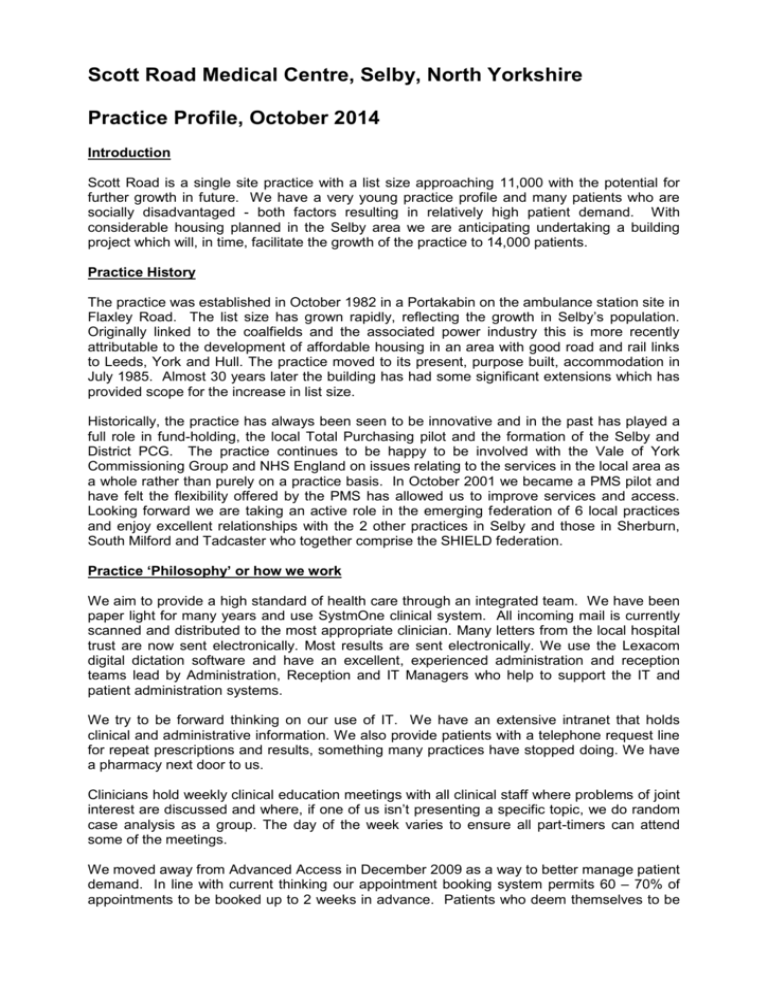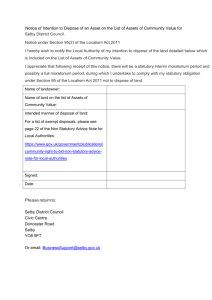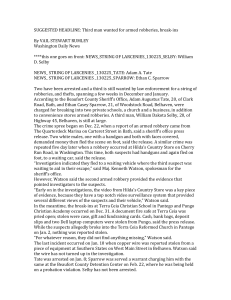Scott Road Medical Centre, Selby, North Yorkshire
advertisement

Scott Road Medical Centre, Selby, North Yorkshire Practice Profile, October 2014 Introduction Scott Road is a single site practice with a list size approaching 11,000 with the potential for further growth in future. We have a very young practice profile and many patients who are socially disadvantaged - both factors resulting in relatively high patient demand. With considerable housing planned in the Selby area we are anticipating undertaking a building project which will, in time, facilitate the growth of the practice to 14,000 patients. Practice History The practice was established in October 1982 in a Portakabin on the ambulance station site in Flaxley Road. The list size has grown rapidly, reflecting the growth in Selby’s population. Originally linked to the coalfields and the associated power industry this is more recently attributable to the development of affordable housing in an area with good road and rail links to Leeds, York and Hull. The practice moved to its present, purpose built, accommodation in July 1985. Almost 30 years later the building has had some significant extensions which has provided scope for the increase in list size. Historically, the practice has always been seen to be innovative and in the past has played a full role in fund-holding, the local Total Purchasing pilot and the formation of the Selby and District PCG. The practice continues to be happy to be involved with the Vale of York Commissioning Group and NHS England on issues relating to the services in the local area as a whole rather than purely on a practice basis. In October 2001 we became a PMS pilot and have felt the flexibility offered by the PMS has allowed us to improve services and access. Looking forward we are taking an active role in the emerging federation of 6 local practices and enjoy excellent relationships with the 2 other practices in Selby and those in Sherburn, South Milford and Tadcaster who together comprise the SHIELD federation. Practice ‘Philosophy’ or how we work We aim to provide a high standard of health care through an integrated team. We have been paper light for many years and use SystmOne clinical system. All incoming mail is currently scanned and distributed to the most appropriate clinician. Many letters from the local hospital trust are now sent electronically. Most results are sent electronically. We use the Lexacom digital dictation software and have an excellent, experienced administration and reception teams lead by Administration, Reception and IT Managers who help to support the IT and patient administration systems. We try to be forward thinking on our use of IT. We have an extensive intranet that holds clinical and administrative information. We also provide patients with a telephone request line for repeat prescriptions and results, something many practices have stopped doing. We have a pharmacy next door to us. Clinicians hold weekly clinical education meetings with all clinical staff where problems of joint interest are discussed and where, if one of us isn’t presenting a specific topic, we do random case analysis as a group. The day of the week varies to ensure all part-timers can attend some of the meetings. We moved away from Advanced Access in December 2009 as a way to better manage patient demand. In line with current thinking our appointment booking system permits 60 – 70% of appointments to be booked up to 2 weeks in advance. Patients who deem themselves to be medically urgent for the same day are triaged by one of the Same Day Care Team (comprising a GP and a Nurse Prescriber). We hold regular one stop review clinics for patients who have complex health issues where we aim to deal with their needs in one extended appointment – more efficient for them and for us. The practice offers extended opening outside of our core hours. This is shared among all doctors and nurses on a proportional basis. Currently we offer an early morning (1 GP), a late evening (1 GP and 1 Nurse) and a short Saturday surgery every other week (1 GP and 1 Nurse) to patients who experience problems in getting to see their GP during our core opening hours. Clinicians try to adopt a ‘counselling approach’ to our patients, giving them time to express their problems and themselves time to offer appropriate advice. Emphasis is placed on preventative care and teaching of self care of minor ailments. Our vision for the coming years is to continue to offer the best service possible to our patients and to develop appropriate services in relation to local needs. The Practice Team Following the recent retirement of our senior partner we currently have 5 partners and 4 salaried GPs. Scott Road is a teaching practice for the Hull and York Medical School. Dr Mary Clatworthy is our Executive Partner (ie leads the business operations). Dr Paul Docherty, Dr Mary Clatworthy and Dr Ruth Walker are all tutors for the HYMS Year 3 students. Paul also works at York University as a Year 2 HYMS tutor and his practice post is job shared with his wife, Caroline, who takes the lead in the practice for child health. Dr Vanessa Wright takes the lead in supervising our HYMS 5 students, supported by Dr Gill Vater. Dr Kath Hodkin takes a particular interest in QOF and leads on prescribing and information governance. Dr Ruth Walker leads is the practice representative on the Vale of York Commissioning Group. Further details about us and the nursing team are on our website. We have an excellent, extensive nursing team with a Nurse Manager, three Minor Illness/Nurse Prescribers, two Practice Nurses and two Health Care Assistants. This skill mix really helps us deliver services to our patient population. All phlebotomy is done at the local hospital or at an Asda superstore in York! At Selby War Memorial Hospital there are some in-patient beds where we sometimes look after patients (usually as a stepping stone from the acute trust to home or residential care or for elderly respite and terminal care). There is also a minor injuries unit that tries to be open 24/7. We do our minor surgery there once a week. The out of hours service is also run from here and two of one of doctor still does out of hours sessions. Some patients are seen in the outpatient department here by visiting consultants from York. There are also Physiotherapy and X-ray facilities here. Other clinicians based at the practice We have a very effective Primary Health Care Team with attached staff housed on site. This has operated as a self managed team over the past 6 years. The team are involved in much of the decision making at the practice and the culture is very much one of involvement for both clinical and administrative staff. In addition to the Primary Health Care Team we offer an inhouse counselling service and also allow the premises to be used weekly by the NHS England psychology Primary Care Mental Health worker. An ultrasound service also uses our rooms to see patients from here and other practices 1 day a week. Selby itself Selby is a diverse area. It is a predominantly rural district of North Yorkshire, situated south of York and east of Leeds with 3 main settlements – Selby town itself, Tadcaster and Sherburn in Elmet. It has a total population of 76,500. The North Yorkshire Moors are a 45 minute drive and the Dales and the coast are within easy reach. The town itself stands on the River Ouse, the focal point being the impressive Abbey dating back to the 11th century. Despite recent developments in the area Selby retains a small town atmosphere with a weekly market and a monthly farmers’ market. Agriculture remains the traditional commercial activity. As well as being an inland port main employers include a flour mill, an animal foodstuff manufacturer and a small chemical works. Retail and industrial parks are rapidly developing within the district. There are plans for a large growth in housing in Selby itself and in the wider community. There are good primary schools and the local comprehensive schools and tertiary college have a good reputation. Private education is available locally and in York and Leeds. In general the district is relatively affluent with a higher than average rate of employment (83%). The area is well served by major roads and there is a direct train service to London as well as access to the East Coast main line at York, Leeds and Doncaster.









